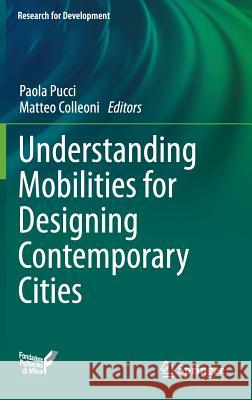Understanding Mobilities for Designing Contemporary Cities » książka



Understanding Mobilities for Designing Contemporary Cities
ISBN-13: 9783319225777 / Angielski / Twarda / 2015 / 274 str.
Understanding Mobilities for Designing Contemporary Cities
ISBN-13: 9783319225777 / Angielski / Twarda / 2015 / 274 str.
(netto: 383,36 VAT: 5%)
Najniższa cena z 30 dni: 385,52
ok. 22 dni roboczych
Dostawa w 2026 r.
Darmowa dostawa!
Understanding Mobilities for Designing Contemporary Cities
Introduction.- Mobility Practices as a Knowledge and Design Tool for Urban Policy.- A Social Science Approach to the Study of Mobility. An Introduction.- Putting Territory to the Test of Reversibility.- Populations and Rhythms in Contemporary Cities.- Planning in Motion. The new Politics of Mobility in Munich.- In Search of an Integrated Mobility Project.- Plug&Play Places: Subjective Standardization of Places in Multilocal Lifeworlds.- Inhabiting Simultaneous Lives: Analysing Process of Reversibilization of Mobility Practices in Italy.- Temporal Efficiency, Temporal Justice and Urban Mobility.- Transport Disadvantage, Car Dependence and Urban Form.- Resident and Non-resident Urban Population: Types of Conflicts.- Metropolitan Dynamics and Mobility Flows. A National Comparative Study (1991-2011).- Mobility Practices in Peri-urban Areas: Understanding Processes of Urban Regionalization in Milan Urban Region.- Mobile Phone Data in Reading Mobility Practices.
Paola Pucci, MSArch and PhD in Territorial Planning (IUAV, 1994), is Associate Professor in Urban Planning at Politecnico di Milano. Dr. Pucci coordinates the PhD Course in Urban Planning, Design, and Policy at the Department of Architecture and Urban Studies, Politecnico di Milano. She has also been a visiting professor at various European universities and taught at the Institut d’Urbanisme, Université Pierre Mendès, Grenoble (2009–2010). She has taken part in Italian and international research into infrastructure and mobility policies and has published books and articles in Italian and international journals. Her latest publications include work on an accessibility index, mobile phone network data as new sources for urban studies, identification of communities of practice through mobile phone data, and progress toward systemic usage of manifold cell phone network data for urban analysis and planning.
Matteo Colleoni is an Associate Professor in Urban Sociology and holds the Chair of Urban Policies in the Department of Sociology and Social Research at Milan Bicocca University. He is also a member of many national and international organizations and networks on mobility and urban life. His research and teaching addresses issues of urban mobility, accessibility & transport exclusion, metropolitan areas & urban change, and time–space analysis. His most recent relevant publications in this context include La città attraente. Luoghi pubblici, mobilità e arte contemporanea (2014), Mobility, Accessibility and Social Equity: A Comparative and Interdisciplinary Empirical Study in the Metropolitan Areas of Milan, Bologna and Turin (2013) and A GIS methodology for defining the metropolitan areas. The Italian case study (2012).
This book explores mobilities as a key to understanding the practices that both frame and generate contemporary everyday life in the urban context. At the same time, it investigates the challenges arising from the interpretation of mobility as a socio-spatial phenomenon both in the social sciences and in urban studies. Leading sociologists, economists, urban planners and architects address the ways in which spatial mobilities contribute to producing diversified uses of the city and describe forms and rhythms of different life practices, including unexpected uses and conflicts. The individual sections of the book focus on the role of mobility in transforming contemporary cities; the consequences of interpreting mobility as a socio-spatial phenomenon for urban projects and policies; the conflicts and inequalities generated by the co-presence of different populations due to mobility and by the interests gathered around major mobility projects; and the use of new data and mapping of mobilities to enhance comprehension of cities. The theoretical discussion is complemented by references to practical experiences, helping readers gain a broader understanding of mobilities in relation to the capacity to analyze, plan and design contemporary cities.
1997-2025 DolnySlask.com Agencja Internetowa
KrainaKsiazek.PL - Księgarnia Internetowa









